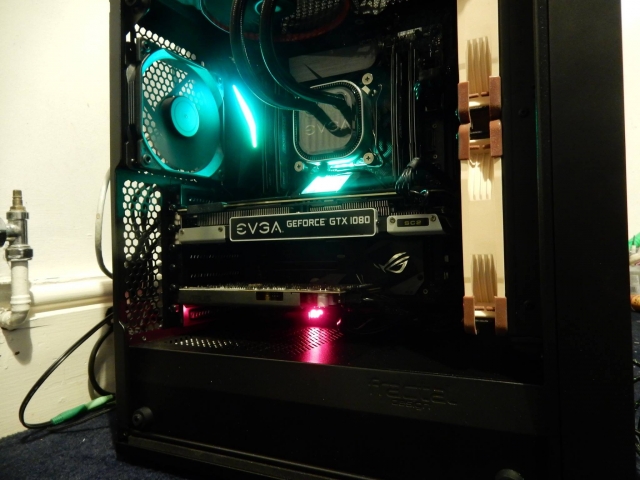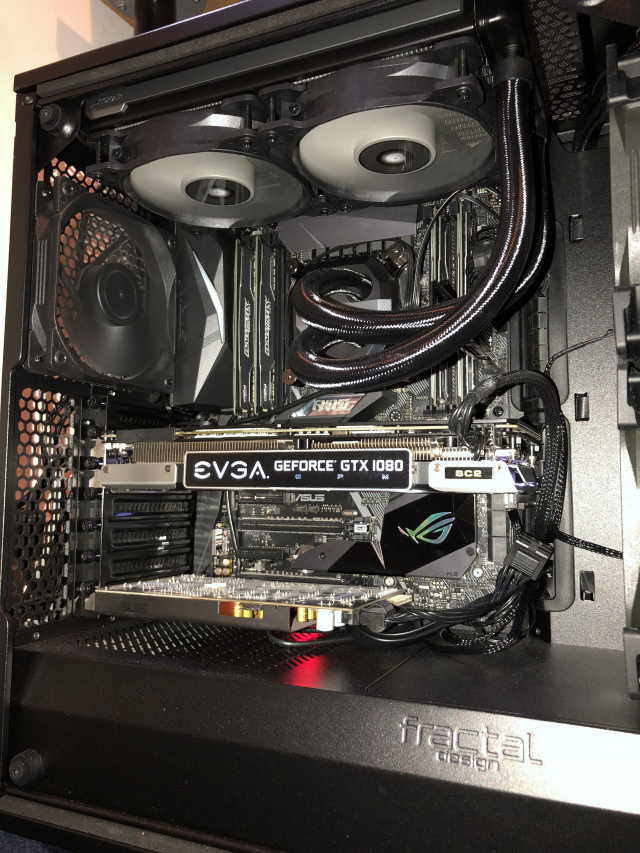
AIO Radiator Placement, Does It Matter?
This was not an article I was ever planning to do. I always assumed that radiator placement made little difference to internal temperatures, I even backed up my thoughts on this by checking out a few YouTube videos.
Recently, however, I performed a few upgrades to my system and noticed the GPU was getting quite loud. My investigations into this lead me to believe that the placement does actually make a difference and, depending on your case, can make a big difference.
My initial setup had the radiator at the front pulling air in the case. I assumed that the GPU fans had to work a lot harder due to hot air from the radiator being dumped onto the GPU, as you can see below they are quite close to each other.
So I decided to do some testing myself and find out the answer.
The main difference between placing the radiator at the front and top is that a radiator in the front could heat components inside the case and a radiator at the top could pull hot air from inside the case through the radiator which could heat up the CPU.
This is the system with a front mounted radiator:

(It's a little hard to see, but there is a radiator behind the two front fans)
And this is the system with a top mounted radiator:

One thing I did differently to the other tests I have seen is not locking any fan speeds in the system, so the GPU/Radiator/case fans were set to the default quiet curves.
In the videos I had watched most had locked the speeds to 60% or so in order to measure temperature changes but I found that 60% didn't make that much difference to temperatures but did produce unacceptable noise levels (in my opinion). Temperatures should stay fairly similar all round with each configuration, but would the fans spin slower on one configuration over the other to maintain the same temperatures? This is the key thing for me as I like having a quiet computer.
Before I show my results I will say that the case I am using is fairly shallow and the front fans/radiator are quite close to the GPU. With a longer/deeper case there may not be as much of a difference. As always though, results may vary depending on your setup.
Setup
The key components of the system are :
- Fractal Design Meshify C case
- Intel Core i7 7820x CPU @ 4.3GHz (Voltage set to auto)
- Asus ROG Strix X299 Motherboard
- EVGA GTX 1080 SC GPU
I used two AIO coolers for this test, one is a 280mm (EVGA CLC 280 Liquid CPU Cooler) and the other is a 240mm (Corsair H100i V2). The reason for the difference is that the top of my case cannot take a 280mm radiator.
I was using a 280mm radiator in the front initially, I then swapped for the 240mm radiator to test my theory. The 240mm radiator, however, is thicker and has tighter packed fins.
Results
I ran two lots of tests. One was a gaming test, which consisted of me running 7 Days to Die standing in my base looking at my two forges until the temperatures leveled out (for some reason this taxes the system a lot). I was in the same location for both tests.
The second test I tried to load up the CPU and ran Boinc on all cores in order to load the CPU a little more. I stuck with the same project (Asteroids @ Home running both CPU and GPU workloads) to try and keep things a fair as I could.
Conclusion
In conclusion, the results show that there is not a huge difference when gaming, but still noticeable from a noise point of view and there is quite a difference when running Boinc (great for people like me that run it 24/7).
The differences are big enough however, that I would recommend mounting the radiator at the top of your case, exhausting air out.
The CPU temperatures were a little higher when the radiator was mounted at the top during gaming and was around seven degrees higher under Boinc, but were still well within safe limits and the fans did not have to speed up to compensate.
The GPU, however, did not run any cooler under gaming, which was to be expected. Although, the fans did run slower which was a lot easier on the ears. Under Boinc, the GPU results were a lot bigger, It ran cooler and the fans run so slow I could not hear them over the rest of the machine.
The boost clocks were also slightly higher, which is always a bonus when gaming.
I wish I had a decibel meter but instead, you'll have to take my word for it.
As always though, your mileage will vary as they say. If quiet computing is your thing and your GPU is air cooled, then the top of the case is the way to go.
I hope this article will help others with their cooling setups and AIO choices.
Terms used in this article
- AIO = All in one, also know as closed loop as the whole unit is in one piece and does not require any complex assembly.
- CPU = Central Processing Unit, the brains of the computer
- GPU = Graphics Processing Unit, Gives you the shiny graphics







COMMENTS
Acelister - 09:17pm, 6th November 2017
A very thorough article. Nice work.
Platinum - 09:27pm, 6th November 2017 Author
Cheers mate, This was an interesting one to do and I learned a few things in the process.
GarySheppard - 06:29pm, 9th November 2017
This is pretty interesting and I didn't expect to see quite such a difference.
Personally, before I switched back to air, I actually had the rad mounted outside of the case entirely, and if you can manage that, then I'd recommend that as the best way, but it's a tricky thing to do.
Platinum - 12:25am, 10th November 2017 Author
Yea that will definitely give you the best cooling
Platinum - 12:38am, 10th November 2017 Author
So I seem to be getting some flak on social media / Reddit for this one for not testing with the fan speeds locked, I wasnt as clear as I could have been in the article about my intentions so let me try and clear this up a bit.
So sure locking the fan speeds at say 50% would give me the best and most accurate CPU temperatures for both mounting points but my aim was to do a more real-world test.
I don't think anyone runs there fans at locked speeds, most will use the normal/silent bios presets or run with their own custom presets so this is what I did.
My aim was to find which way gave the best overall results, sure the front mount gave better CPU temps but at both locations the tempritures were both very acceptable and the fans didnt have to speed up much at all to compensate, but with the top mount the GPU fans had to work less to keep the card cool due to not having to also disipate the hot air coming from the CPU rad.
Overall I found the lower noise levels and slightly higher CPU temps of the top mounting to be the best 24/7 setup and I think most people would agree with me there.
So yea I should have been clearer stating that this was not a "which cools the CPU better" article, I will try better next time :)
Calmine - 08:27pm, 13th November 2017
Excellent article, Plat. Interesting to know. I will certainly take this into account for when I upgrade my system.
Platinum - 08:44pm, 13th November 2017 Author
Cheers dude :)
The depth of your case should make a difference as well, deeper cases should have more room to dissipate the hot air before it hits the GPU.
Shorter cases are becoming more popular now since we ditched the optical drive though :)
TGK - 08:57pm, 13th November 2017
I've never actually used a radiator so this will come in handy at some point for sure. Nice one Plat, especially like the graphs.
Platinum - 09:46pm, 13th November 2017 Author
Cheers :) Big thanks to wowky for the graphs :)
D - 05:25pm, 21st February 2021
Front mount radiator is up-side down (tubes should be on bottom of radiator to stop air from pumping instead of water) and still had better CPU numbers?
Arotro - 12:56pm, 6th January 2024
As a PC enthusiast, I've often wondered about the intricacies of GPU fans, and your blog provided the answers I was seeking. The in-depth explanation of why <, along with practical advice for users, makes it an invaluable resource. Your dedication to user education is evident throughout the article.